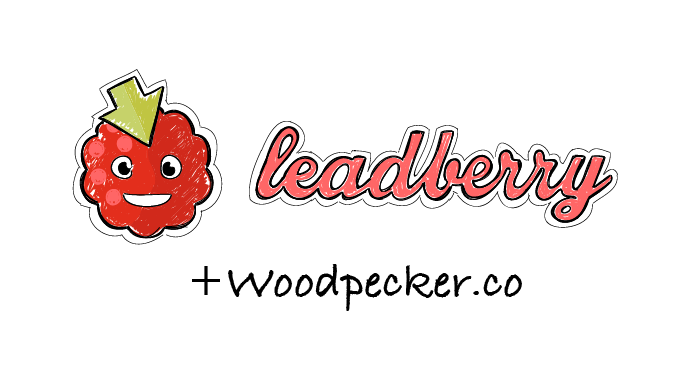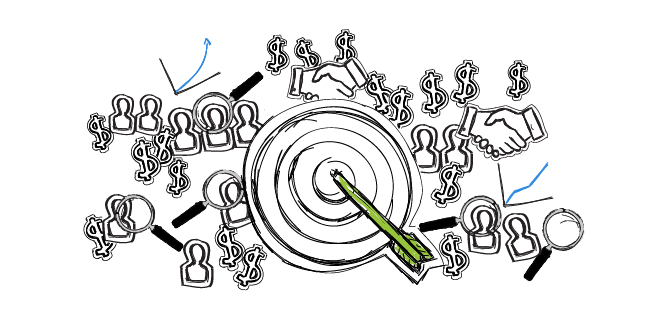If you’re doing outbound sales, you’ve probably heard about the ABSD (Account Based Sales Development) trend lately. Is it new? Is it for everyone? Is it a revolutionary approach that will bring you $$$ as soon as your sales team adopts it? What is it, really? Check out the short introduction to ABSD in simple words.
When I first heard about ABSD, I thought it’s going to be a totally revolutionary approach to outbound marketing and sales. When you coin a new fancy name for something, spelled with capital letters which in result becomes an acronym, that’s going to be something big, right?
Well, it is great! But I wouldn’t say it’s revolutionary. There’s a few characteristics of the framework that might already sound familiar to you (especially if you’re reading this blog for some time).
Account Based Sales Development characteristics
You focus on company (account) first
You don’t start from a marketing persona, like VP of Sales at an IT company with 50-100 employees. You start from defining your Ideal Customer Profile, and by the customer you understand a company, not a person. A company of specific type, within a specific industry, of a specific size, with specific product/service and a specific target market.
You pick just a few companies that match the profile. And you focus your entire marketing and sales efforts on them. That sounds familiar, doesn’t it?
Check:
What’s the First Step to Building a Good Prospect Base?
What Does “Ideal” Really Mean in the Ideal Customer Profile?
You thoroughly research your prospects
Ideally, in the ABSD approach you hire SDRs (Sales Development Reps) who are a bit like spies, looking for all information they can find about the chosen companies matching your ICP. Then, they target decision makers (often it’s not just one person at a company), who could be potentially interested in buying your product.
In the next step, the SDRs thoroughly research the chosen decision makers, to get as much information as they can, so your sales reps could use it when talking to the prospects. Here’s a great post by Zach Barney about ABSD, that gives a nice example of what the SDR’s job may look like.
Check:
How to Make My Cold Emails Personal? Vol.1: Research on My Prospects
You contact the prospects with multiple highly-personalized messages
Using the precious information collected in the research phase, your SDRs prepare a super-targeted and highly personalized outreach. They write email sequences including several follow-ups, they can call and reach out via other channels, for instance social media.
The messages are focused on the prospect’s company: their successes, recent events, problems and needs. The context for meaningful business conversation is the key here. It’s not about pitching your solution. It’s about showing your prospect why and how your solution may become a fitting piece of their unique company puzzle.
Check:
3 Steps to Highly Personalized Cold Emails
And the SDRs don’t just reach out to a single person. They are trying to contact a few people from the same company at the same time, to use the organization mechanisms, a bit like in Bryan Kreuzberger’s Breakthrough Email system, I described among others in 15 Cold Email Templates. They persistently keep sending messages via different channels, to start a relation and then to nurture it.
Check:
5 Rules of Effective Follow-up
You build valuable, long-term relationships with potential customers
You don’t expect them to buy from you after 3 emails. You get ready for a long, complicated, multi-level decision process. You engage at as many levels as you can. You basically aim at becoming friends with them before they actually decide to buy from you.
And finally, you’re open to help the company implement your solution for multiple users. You’re prepared to maintain the solution for numerous user accounts, and your support team gets ready to assist the users anytime they need help. In other words, you get ready for a big commitment, because you expect a big commitment from your prospect.
Speaking of commitments…
Old-fashioned outbound sales vs. ABSD
I’ve read somewhere (can’t remember where, so if you recognize this bit, please let me know in the comments) a great comparison of the traditional outbound to a pursuit of girls at a bar.
When you’re sending thousands of poorly targeted emails, you’re like a guy who’s “ideal girl profile” is every blonde under 30.
And guess what familiar character that made me think about…

Yes. Barney. Barney Stinson from How I Met Your Mother. His ideal girl profile was very simple, more or less summarized in the metaphor above. He wasn’t looking for commitment. He used cheap tricks to pick up whichever hot chick in a bar. When you think of high-quantity, low-quality, product-oriented outreach, think of Barney’s girl pursuit methods.
On the other hand, there’s of course Ted.

“Last Forever Parts One and Two” ÄîTed finally finishes telling his kids the story of how he met their mother, on the special one-hour series finale of HOW I MET YOUR MOTHER, Monday, March 31 (8:00-9:00 PM, ET/PT) on the CBS Television Network. Pictured: Josh Radnor as Ted, Cristin Milioti as Tracy. Photo: Ron P. Jaffe/Fox ¬© 2014 Fox Television. All rights reserved
Ted’s ways of looking for the girl are a bit like looking for perfect customers within the ABSD approach. He’s looking for “the one”. He’s patient in waiting for “the one”. He’s ready for a long-term commitment. He’s willing to invest lots of time and effort to get the perfect girl. So, when you think of ABSD, think of Ted’s girl pursuit methods.
Ok, enough for the TV shows metaphors, let’s get back to business.
When you definitely DON’T want to apply ABSD
As it turns out, ABSD is not a new golden method to make you rich, whoever you are. It’s just not for everyone. And if you try to apply it when you aren’t supposed to, you’re most probably going to lose a lot instead of gaining. So pay attention. Here’s when you definitely DO NOT want to engage in ABSD.
1) If you intend to close deals smaller than $50 000
ABSD takes time of multi-member teams, lots of thorough research, and persistent, well-thought-out outreach. Neither of these things is cheap. The method requires huge investment, so it only makes sense financially if you aim at a significant return. In this post, Brandon Redlinger features a comment by Trish Bertuzzi who points to the ammount of $50K as the minimum deal value for applying ABSD.
2) If you haven’t reached product/market fit yet and your solution is not stable
You need to be at the stage when you have your Ideal Customer Profile specified. You’re going to spend a lot of time and money researching your prospects and waiting for the sales process to get completed. You can’t afford to do that if you’re still figuring out what types of customers will benefit from your solution. You need to be sure that the companies you’ve chosen will benefit from it.
Let’s face it, if you’re going to sell for over $50 000 a deal, you want to get about big fish. And you can’t expect the big fish to forgive you bugs and instability of your solution. You can’t risk that a whole department at an enterprise will suddenly lose access to the software you’re providing. You can’t suppose two guys in your support team will suddenly handle 500 new users. in short, you just need to be ready to chase the big fish.
3) If you’re not ready to hire and train the team of SDRs
Effective SDRs are the key to the effectiveness of the ABSD approach. And the job of an SDR is a hustle. So they need to be the right people at the right place – you want people with intuition. They need to learn how to create appropriate messaging and manage well-prepared outreach campaigns including lots of personalization elements. They need to communicate very well with marketing and sales. And finally, they need to be provided with a set of tools that will make their job bearable.
4) If you don’t believe in automation
Provided with powerful reasearch and outreach automation tools, your SDRs will hustle. Their job is going to be hard anyway. Non-provided with any kind of automation, your SDRs will die trying to deliver some results. Their job will make little sense.
So if you really take ABSD seriously, you need to be ready to implement some well coorditaned processes of data collection and management, as well as some solutions to automate personalized outreach.
What’s in it for you?
Even if ABSD is not for you yet, there are some characteristics of the approach that you should be incorporating into your outbound outreach anyway.
You don’t have to close deals over $50K to work out your Ideal Customer Profile. You don’t need to have a team of SDRs to send emails focused on your prospects instead of your product. And you don’t need to have reached product/market fit to realize that it is customer success that you should be focusing on the most.
For almost two years now, I’ve been preaching on this blog to focus on building relations through cold emails, and not on trying to sell straight ahead. I’ve been writing about how true and honest personalization affects the effectiveness of outreach. I’ve been emphasizing the importance of valuable and persistent follow-up. I’ve been pointing out that a well prepared outreach campaign takes time and effort, but it’s totally worth it in the end.
Now, you can only imagine the overwhelming joy I felt, when I discovered that some renown sales companies from the US spread all those ideas under a fancy four-letter abbreviation: ABSD. I can honestly only hope this particular trend in sales will last and thrive.
READ ALSO

What Should I Learn About a Company Before Sending Them a B2B Sales Email?
This is a piece inspired by a very good question I've come across on Quora. It will be especially helpful to those of you who either prepare to start their first sales email copy, or they've been sending cold emails that don't bring the desired effects.

How Leadberry Automates Email Outreach with Woodpecker
There's a group of prospects that visit your website at least once but they don't take any action whatsoever. They don't sign up for a free trial, they don't sign up for a newsletter. Sometimes they might do that out of distraction, heavy workload, or absent-mindedness rather than them not liking your offer. Zoltan Gero, our guest writer for today, believes it's a perfect reason – a trigger – to contact those prospects by sending them a not-so-cold email campaign. He describes a step-by-step process of contacting those companies using Leadberry and Woodpecker integration via Zapier.

Lean Approach to Email Outreach, or How Big Should My Cold Email Campaign Be?
Our users sometimes report to us that they couldn't find enough time to run their outbound campaigns. Yes, a well-thought-out cold email campaign takes some time to get prepared. But what we often observe is that cold email senders want to go large from the very beginning: have a prospect base including thousands of addresses, an 8-touch email sequence with A/B testing, and so on. In this post, I'm going to show you why it's more beneficial to start small. Check out what we call the lean approach to cold email, and why it's worth testing.

